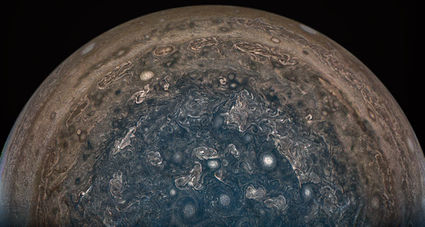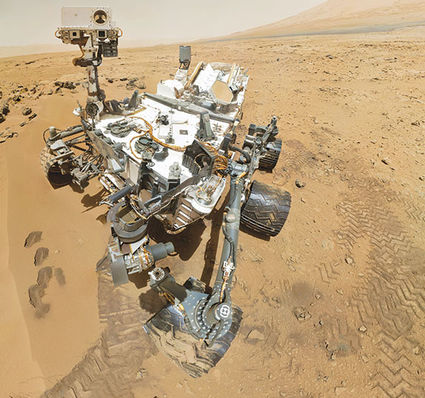The year of 'Mission Ends'
Sky Watch - Keeping an eye above the horizon!
Last month I focused our eyes on the many exciting manned space activities underway this year. However, there's a great deal of action in the unmanned space arena, as well. Space exploration is a primary NASA mission; and nothing has been a better return on investment than our interplanetary space probes.
Working from the sun outward, Messenger ended its mission at Mercury last year after giving us high-resolution images of nearly the entire planet.
Japan is exploring Venus with its Ataksuki space probe. It has already revealed a massive planet-wide wave in its cloud tops. Curiously, although the winds in the cloud tops scream along at 200 mph, this feature remained fixed over the planets' surface.
Mars has no less than six operational satellites in orbit, plus two rovers on the surface. NASA-JPL designed and operates Mars Odyssey and the Mars Reconnaissance Orbiter, while NASA's Goddard Spaceflight Center is operating MAVEN (Mars Atmosphere & Volatile Evolution). This probe actually dips down into the upper reaches of the Martian atmosphere in an effort to help us understand how and why Mars lost most of its atmosphere.
India is also pitching in with its Mars Orbiter Mission. The European Space Agency's (ESA) first interplanetary mission, Mars Express, is still sending back good images and data after 13 years. ESA and Russia's Roscosmos delivered the ExoMars Trace Gas Orbiter to orbit last December. After a number of aerobraking maneuvers, it will begin its science mission later this year.
And lest we forget the two little rovers that won't quit! Opportunity has been exploring for over 13 years. In that time it has covered over 44 km (27 mi.)--more than the distance of a marathon! Curiosity has traveled over 15 km (9 mi.) in the last five years.
All of these missions rely on NASA-JPL's Deep Space Network for communications.
Beyond Mars is the Asteroid Belt. The largest asteroid is Ceres, which is large enough to be rated a 'dwarf planet.' After exploring the asteroid Vesta for 14 months, NASA-JPL's Dawn space probe continued on to Ceres. Once arriving in March of 2015, Dawn has been routinely changing its orbit. In October of 2015, it spent two months in a tight Low Altitude Mapping Orbit of only 375 km (233 mi.). Now (April 20) Dawn is back out to 20,000 km (12,400 mi.). The probe will run out of fuel later this year, ending the mission in the June time frame.
Beyond the Asteroid Belt are the Gas Giant Planets: Jupiter, Saturn, Uranus, and Neptune. Juno is on a daring mission to map Jupiter's magnetosphere (the planet's magnetic field), among other things. It's highly elliptical polar orbits bring it close to the planet every 53 days. While images are not a primary science mission, the JunoCam operated by citizen scientists is returning amazing images. The mission is expected to continue at least into mid-2018. However, the harsh Jovian environment and NASA budget issues are problematic.
Further out, Cassini is still exploring Saturn in grand style. After successfully landing ESA's Huygens lander on Titan in 2005, Cassini has dazzled us all with breathtaking images. It has shown us hexagonal storms on Saturn's South Pole, intricate patterns in its rings, discovered many new moons, and even gave us a hi-res backlit portrait of Saturn with us (as a pale blue pixel) in the background. That mission will end in September when Cassini plunges into the Saturnian cloud tops.
Further yet, New Horizons is on its way to Kuiper belt object 2014 MU69 (no word yet on a name for this critter). It's scheduled to arrive on New Years Day of 2019.
Beyond that are the Voyager probes, which are exploring the very boundaries of the Solar System and the depths of interstellar space. I'm sure it will be a long time before another probe (let alone a human being) overtakes them.
As you can see, there is a lot of exploration going on out there amongst the planets. We see fine missions going the distance and way beyond. Several will come to an end this year or next. What we don't see are new interplanetary missions going up this year. Why? Remember a little thing called 'sequestration?' NASA's budget has had a death grip on its throat for four years. It's all they can do to keep the Space Station aloft and avoid killing current projects. Now things are less certain than ever.
Whatever your opinion, it's time to put in your two cents and tell your representatives how you feel as they hash over budget priorities. My opinion: We shouldn't rest on our laurels. These magnificent interplanetary missions have given us great insights, and have raised many more questions to be answered. These programs are a great way to keep high-paying American jobs right here. The 'human adventure' has just begun!
Almanac
Jupiter rises just before the sun sets in May. Having just passed opposition last month (and thus close and large), Jupiter is well placed for viewing all month.
Mars is still hanging in there in the western evening sky, but it will be quite low by months-end. Next month it will be lost in the sun's glare until it reappears in the morning skies of August.

NASA/JPL-Caltech/SwRI/MSSS/John Landino
We can't look down on a planet's poles from the earth; and our probe usually fly by or orbit their equator. That makes this new image of Jupiter's South Pole very striking.
Those who miss the dazzling light of Venus that graced our evening sky all winter will be happy to see her in the eastern dawn sky, where she'll be for most of the rest of the year.
Saturn now rises before midnight and reaches its highest point in the south (transiting) before morning twilight. The rings are still tilted near their maximum "showoff angle" of 26 degrees.
Comet 41P/Tuttle-Giacobini-Kresak passes by Vega and Hercules in May on its way to the far reaches of the Solar System. Though barely bright enough to see with keen naked eyes, it's known for bright outbursts. It will dim this month from 6th to 8th magnitude, making it still a fine target for binoculars. Go to is.gd/4pcometcampaign for a printable finder chart.
Sunrise/Sunset: 6:03 a.m./7:39 p.m. (May 1)
Full moon: May 10
New moon: May 25





